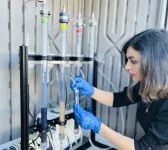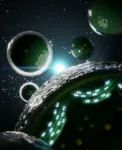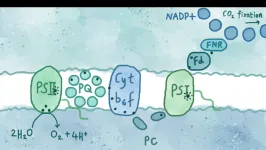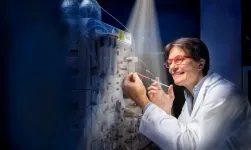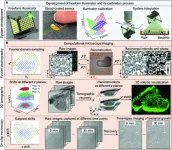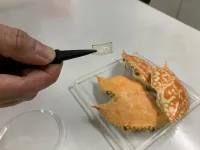(Press-News.org) Engineers at the University of British Columbia have developed a new water treatment that removes “forever chemicals” from drinking water safely, efficiently – and for good.
“Think Brita filter, but a thousand times better,” says UBC chemical and biological engineering professor Dr. Madjid Mohseni, who developed the technology.
Forever chemicals, formally known as PFAS (per-and polyfluoroalkyl substances) are a large group of substances that make certain products non-stick or stain-resistant. There are more than 4,700 PFAS in use, mostly in raingear, non-stick cookware, stain repellents and firefighting foam. Research links these chemicals to a wide range of health problems including hormonal disruption, cardiovascular disease, developmental delays and cancer.
To remove PFAS from drinking water, Dr. Mohseni and his team devised a unique adsorbing material that is capable of trapping and holding all the PFAS present in the water supply.
The PFAS are then destroyed using special electrochemical and photochemical techniques, also developed at the Mohseni lab and described in part in a new paper published recently in Chemosphere.
While there are treatments currently on the market, like activated carbon and ion-exchange systems which are widely used in homes and industry, they do not effectively capture all the different PFAS, or they require longer treatment time, Dr. Mohseni explained.
“Our adsorbing media captures up to 99 per cent of PFAS particles and can also be regenerated and potentially reused. This means that when we scrub off the PFAS from these materials, we do not end up with more highly toxic solid waste that will be another major environmental challenge.”
He explained that while PFAS are no longer manufactured in Canada, they are still incorporated in many consumer products and can then leach into the environment. For example, when we apply stain-resistant or repellent sprays/materials, wash PFAS-treated raingear, or use certain foams to put down fires, the chemicals end up in our waterways. Or when we use PFAS-containing cosmetics and sunscreens, the chemicals could find their way into the body.
For most people, exposure is through food and consumer products, but they can also be exposed from drinking water – particularly if they live in areas with contaminated water sources.
Dr. Mohseni, whose research group also focuses on developing water solutions for rural, remote and Indigenous communities, noted: “Our adsorbing media are particularly beneficial for people living in smaller communities who lack resources to implement the most advanced and expensive solutions that could capture PFAS. These can also be used in the form of decentralized and in-home water treatments.”
The UBC team is preparing to pilot the new technology at a number of locations in B.C. starting this month.
“The results we obtain from these real-world field studies will allow us to further optimize the technology and have it ready as products that municipalities, industry and individuals can use to eliminate PFAS in their water,” said Dr. Mohseni.
Interview language(s): English, Farsi
Research video (b-roll): Dropbox
END
New UBC water treatment zaps ‘forever chemicals’ for good
2023-03-22
ELSE PRESS RELEASES FROM THIS DATE:
Photosynthesis ‘hack’ could lead to new ways of generating renewable energy
2023-03-22
Researchers have ‘hacked’ the earliest stages of photosynthesis, the natural machine that powers the vast majority of life on Earth, and discovered new ways to extract energy from the process, a finding that could lead to new ways of generating clean fuel and renewable energy.
An international team of physicists, chemists and biologists, led by the University of Cambridge, was able to study photosynthesis – the process by which plants, algae and some bacteria convert sunlight into energy – ...
Simulated terrible drivers cut the time and cost of AV testing by a factor of one thousand
2023-03-22
Photos // Video
The push toward truly autonomous vehicles has been hindered by the cost and time associated with safety testing, but a new system developed at the University of Michigan shows that artificial intelligence can reduce the testing miles required by 99.99%.
It could kick off a paradigm shift that enables manufacturers to more quickly verify whether their autonomous vehicle technology can save lives and reduce crashes. In a simulated environment, vehicles trained by artificial intelligence perform perilous maneuvers, forcing the AV to make decisions that confront drivers only rarely on ...
Multiple substance use disorders may share inherited genetic signature
2023-03-22
A new study suggests that a common genetic signature may increase a person’s risk of developing substance use disorders, regardless of whether the addiction is to alcohol, tobacco, cannabis or opioids. The research, led by Washington University School of Medicine in St. Louis, eventually could lead to universal therapies to treat multiple substance use disorders and potentially help people diagnosed with more than one.
Published March 22 in the journal Nature Mental Health, the study’s findings are drawn from an analysis of genomic data from more than 1.1 million people of mostly European ancestry and a smaller ...
How vision begins
2023-03-22
Researchers at the Paul Scherrer Institute PSI have deciphered the molecular processes that first occur in the eye when light hits the retina. The processes – which take only a fraction of a trillionth of a second – are essential for human sight. The study has now been published in the scientific journal Nature.
It only involves a microscopic change of a protein in our retina, and this change occurs within an incredibly small time frame: it is the very first step in our light perception and ability to see. It is also the ...
New NIH study reveals shared genetic markers underlying substance use disorders
2023-03-22
By combing through genomic data of over 1 million people, scientists have identified genes commonly inherited across addiction disorders, regardless of the substance being used. This dataset – one of the largest of its kind – may help reveal new treatment targets across multiple substance use disorders, including for people diagnosed with more than one. The findings also reinforce the role of the dopamine system in addiction, by showing that the combination of genes underlying addiction disorders was also associated with regulation of dopamine signaling.
Published ...
Surprisingly simple explanation for the alien comet 'Oumuamua's weird orbit
2023-03-22
In 2017, a mysterious comet dubbed 'Oumuamua fired the imaginations of scientists and the public alike. It was the first known visitor from outside our solar system, it had no bright coma or dust tail, like most comets, and a peculiar shape — something between a cigar and a pancake — and its small size more befitted an asteroid than a comet.
But the fact that it was accelerating away from the sun in a way that astronomers could not explain perplexed scientists, leading some to suggest that it was an alien spaceship.
Now, a University of California, Berkeley, astrochemist ...
Smaller, denser, better illuminators for computational microscopy
2023-03-22
Seeking to expand the possibilities offered by programmable illumination, a group of researchers at the University of Connecticut developed a strategy for constructing and calibrating freeform illuminators offering greater flexibility for computational microscopy. Their calibration method uses a blood-coated sensor for reconstruction of light source positions. They demonstrated the use of calibrated freeform illuminators for Fourier ptychographic microscopy, 3D tomographic imaging and on-chip microscopy and used a calibrated freeform illuminator in an experiment to track bacterial growth.
The group’s research was published Feb. 20 in Intelligent Computing, a Science ...
Binghamton University reaches highest ever score for LGBTQ+ inclusion
2023-03-22
BINGHAMTON, N.Y. -- Binghamton University, State University of New York scored a nearly perfect ranking on the latest national Campus Pride Index, which measures a university’s commitment to LGBTQ+ safety and inclusivity on campus. The University received a 4.5 out of 5, an increase from the 3.5 scores received in previous years.
Nicholas Martin, assistant director of the LGBTQ Center at Binghamton University, sees this as a reflection of the organization’s dedication and Binghamton’s real commitment to outreach.
“Our ...
Researchers make biodegradable optical components from crab shells
2023-03-22
WASHINGTON — Researchers have developed a process to turn crab shells into a bioplastic that can be used to make optical components known as diffraction gratings. The resulting lightweight, inexpensive gratings are biodegradable and could enable portable spectrometers that are also disposable.
“The Philippines is known for delicious seafood, but this industry is also a source of large amounts of solid waste such as discarded crab shells,” said research team leader Raphael A. Guerrero, from Ateneo de Manila University in the Philippines. “We wanted to find an alternative use for crab shell ...
Beethoven’s genome offers clues to composer’s health and family history
2023-03-22
University of Cambridge Media Release
Beethoven’s genome offers clues to composer’s health and family history
UNDER STRICT EMBARGO UNTIL 11:00 US ET / 15:00 UK / 16:00 CET ON WEDNESDAY 22nd MARCH 2023
International team of scientists deciphers renowned composer’s genome from locks of hair.
Study shows Beethoven was predisposed to liver disease, and infected with Hepatitis B, which – combined with his alcohol consumption – may have contributed to his death.
DNA ...
